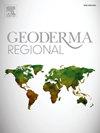来自不同生物群系的巴西拉托索(Ferralsols, Oxisols):南美洲最风化的热带土壤空间变异性的多代理研究
IF 3.3
2区 农林科学
Q2 SOIL SCIENCE
引用次数: 0
摘要
巴西Latossolos (Ferralsols-WRB, Oxisols-Soil Taxonomy)是一种排水良好、蚀变强烈、蚀变深度深、富含Al和Fe氢氧化物、营养不良、形态均匀的土壤,主要受长期风化和连续淋滤作用的影响。尽管在巴西全境都有发生,但人们对拉托索罗基本属性在全国范围内的可变性知之甚少。我们假设巴西Latossolos在土壤属性方面存在相当大的变异性,可以根据巴西不同生物群系的环境特征进行区域表现和追踪。通过这种方式,我们比较了来自亚马逊、大西洋森林、塞拉多和Caatinga生物群系的Latossolos Amarelos、Latossolos Vermelho-Amarelos和Latossolos Vermelhos的一套土壤属性,使用了由已发表的土壤调查产生的可靠遗留数据。Vermelhos是风化程度最大的亚目,表现出最高的铁和铝氢氧化物含量、粘土质地、最大的微团聚体发育、pH和碱饱和度,表现出最低的有效磷含量。相反,Latossolos Amarelos表现出最高的高岭石、粉砂、砂含量,以及最高的土壤稠度和铝饱和度。而Vermelho-Amarelos则表现出中间特征,证实了土壤颜色是区分不同生物群系的Latossolos成土发育的关键属性。与巴西生物群系相比,塞拉多和大西洋森林的拉托索洛风化程度最大,Ki、Kr、粉土比最低,脱硅、铁氧体化、三水石化、壤化等特征强烈。尽管亚马孙地区赤道气候湿热,土壤酸度普遍较高,但亚马孙Latossolos土壤的成土发育程度低于Cerrado和大西洋森林土壤,这与沉积母质、森林硅循环的恢复作用、地形的抑制和土壤内部排水能力差密切相关。来自半干旱Caatinga的Latossolos表现出最低的风化和成土程度,代表了过去湿润气候的残余土壤,保存在巴西唯一的半干旱生物群系中。本文章由计算机程序翻译,如有差异,请以英文原文为准。
Brazilian Latossolos (Ferralsols, Oxisols) from different biomes: a multiproxy study on the spatial variability of the most weathered tropical soils in South America
The Brazilian Latossolos (Ferralsols-WRB, Oxisols-Soil Taxonomy) are generally well-drained soils, strongly and deeply altered, rich in Al and Fe oxyhydroxides, nutrient-poor and morphologically uniform, due to long-term weathering and continuous leaching. Despite the occurrence in all Brazilian territory, little is known about the variability of basic attributes of Latossolos across the country. We hypothesize that the Brazilian Latossolos present a considerable variability in soil attributes that can be regionally manifested and traced according to the environmental characteristics of different Brazilian biomes. In this way, we compared a suite of soil attributes from Latossolos Amarelos, Latossolos Vermelho-Amarelos and Latossolos Vermelhos from the biomes Amazonia, Atlantic Forest, Cerrado, and Caatinga biomes, using robust legacy data produced by published soil surveys. The Latossolos Vermelhos represent the suborder with the greatest degree of weathering, exhibiting the highest contents of Fe and Al oxyhydroxides, clayey texture, greatest microaggregate development, pH and base saturation, and presenting the lowest contents of available P. Conversely, the Latossolos Amarelos exhibited the highest contents of kaolinite, silt, sand, and the highest soil consistency and Al saturation. The Latossolos Vermelho-Amarelos, in turn, presented intermediate characteristics, confirming that soil color is a key attribute for differentiating the pedogenetic development of Latossolos, regardless of the biome. With reference to the Brazilian biomes, the Latossolos of the Cerrado and Atlantic Forest presented the greatest weathering degree, evidenced by the lowest values of Ki, Kr, and silt/clay ratios, as well as other characteristics that reveal the great intensity of desilication, ferralitization, gibbsitization and pedalization. Despite the hot and wet equatorial climate and the general soil acidity in Amazonia, Amazonian Latossolos presented lower pedogenetic development than the Cerrado and Atlantic Forest soils, which are in close association with the sedimentary parent material, resilication by forest Si cycling, subdued topography and poor soil internal drainage. The Latossolos from the semi-arid Caatinga showed the lowest weathering and pedogenesis degrees, and represent relict soils from past wetter climates, preserved in the only Brazilian semi-arid biome.
求助全文
通过发布文献求助,成功后即可免费获取论文全文。
去求助
来源期刊

Geoderma Regional
Agricultural and Biological Sciences-Soil Science
CiteScore
6.10
自引率
7.30%
发文量
122
审稿时长
76 days
期刊介绍:
Global issues require studies and solutions on national and regional levels. Geoderma Regional focuses on studies that increase understanding and advance our scientific knowledge of soils in all regions of the world. The journal embraces every aspect of soil science and welcomes reviews of regional progress.
 求助内容:
求助内容: 应助结果提醒方式:
应助结果提醒方式:


